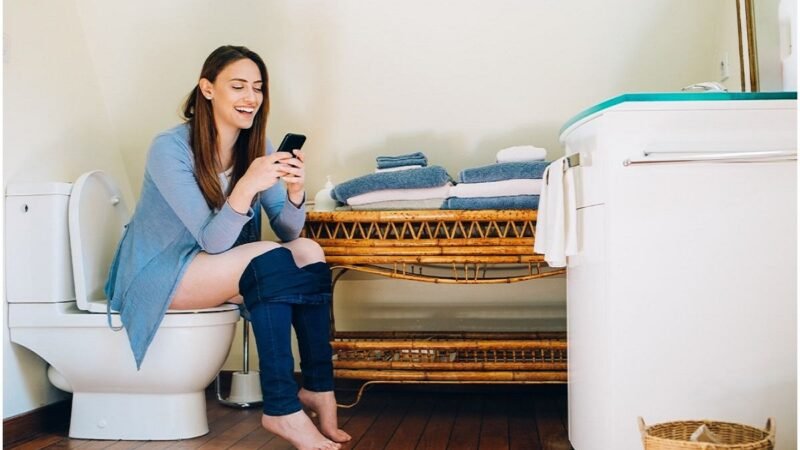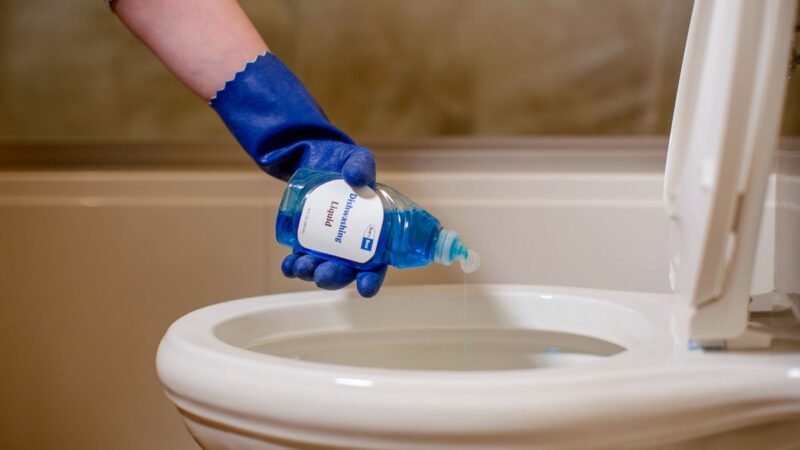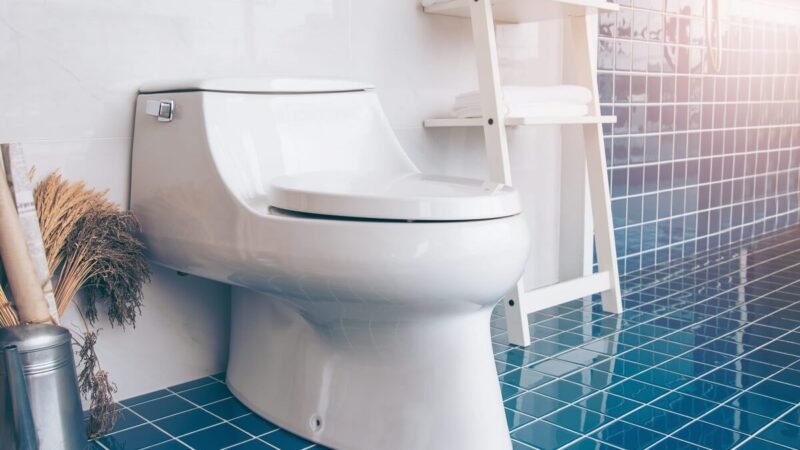Why is My Toilet Water Brown?

A dirty toilet is almost the worst thing that can happen. But what happens when your toilet is clean but the water in it is brown?
Most likely, the water in your toilet is brown because there is rust in your system. Old galvanized pipes can rust, which will turn your water a different color. Your water could also have a lot of iron compounds in it.
Even though the rust itself is not dangerous to your health fit, it can stain the toilet and help nasty bacteria grow. In this article, we’ll show you how to figure out why the water in your toilet is brown. Some of these reasons are galvanized pipes that have rusted, minerals that have built up in hard water, a clogged pipe, or a broken well system.
Table of Contents
What Causes Brown Water In Toilet
Flush your toilet again before you go on. There are times when you just have a lot of residues that will go away. Most of the time, one flush isn’t enough to get rid of all the waste, and the flush cycle needs to end completely.
Even if the water in the toilet is still brown, it’s not because of poop. Still, you have to find and fix the cause.
To figure out why the water in your toilet is brown, you should first look at other water sources in your home. Check the water in all of your sinks, the tub, and any other faucets you have.
Check both the hot and the cold water. This is the way to figure out why the water in the toilet is brown. You will have two choices.
Why is My Toilet Water Brown
1. Clogged Plumbing System
A clogged toilet is a common problem. Most of the time, people throw and try to flush things like diapers and wipes that can’t be flushed.
Even if they don’t stay in the toilet bowl, they still clog the pipes. When a toilet is clogged, water flows backward and turns clear toilet water brown. Even though a clogged toilet is common, it is a big problem that can damage the drain.
Read more: Are Toilet Seats Universal
2. Worn Out Toilet from Use
Toilets can wear out from being used every day. It’s possible that the cracks in your toilet haven’t been cleaned in a long time. Flush your toilet well and use a brush to clean the bowl all the way through. Make sure that all the trash is gone, and then check to see if the brown water problem still exists.
3. Day-to-Day Use
The first thing you should do to figure out why the water in your toilet is brown is to flush the toilet. There’s a chance that your toilet didn’t get rid of all of its waste, and it may need to be flushed again. If more brown water rushes into the bowl, the problem is getting worse.
4. Rusted Pipes
The first thing you need to do is check every tap in your home, from the sink or shower in your bathroom to the faucet in your kitchen. If brown water comes out of every tap in your house, there is a problem with the plumbing system as a whole.
This means that your water has too much iron. This is especially true for homes that get their water from a well or in cities where the water has more iron than in most cities. When this happens, the amount of rust can get out of hand and cause a problem.
5. Well Water Issues
If your well water has been tainted by organic matter, like an animal or human waste, the water in your toilet may be brown.
This is because the iron minerals in your water have reacted with the organic material, making rust stains.
6. Toilet Waste
Brown toilet water is often caused by waste from the toilet. Leaving these things in the toilet makes it look and smell bad. But other organic leftovers aren’t a big problem because they break down quickly.
Most of the time, the leftovers stay in the toilet bowl because the flushing pressure isn’t strong enough. A good, normal toilet should have a flush system that gets rid of both used toilet paper and human waste.
7. Hard Water Mineral Buildup
Clogged pipes are another reason why the water in your toilet might be brown. If your plumbing system is not too old, this doesn’t apply to you. Minerals in hard water can cause pipes to get clogged. When manganese and calcium combine with oxygen in your toilet’s tank, the water immediately turns brown. And if you use a certain toilet cleaner, these minerals can even build up.
Read more: How Doxycycline Ruined My Life
8. A Damaged Well
If you have a well, the brown color in your toilet could also come from organic matter that has broken down in the well. The water might also have sediment in it. Most of the time, this means that your well has been broken in some way. It could have been hurt by a storm or by landscaping or building work that was done recently.
When wells break, professionals should fix the system.
9. Clogged Pipes
This is hard to figure out. Your pipes might be clogged if things are coming back up into the toilet bowl. You’ll need a plumber to check it out. A plumber will have to check your plumbing system to see if there is a clog and clear it out if there is one. You don’t have the skills or tools to do this as a homeowner.
Also, you need to take care of this right away. If you leave your pipes clogged, the pressure can cause them to burst or crack. If your pipe cracks or bursts, it will cost a lot more to fix than if it was just clogged.
Also, if a pipe bursts, water can back up into your bathroom and even cause mold to grow. You can clean up the mess yourself or hire a company that fixes water damage.
10. A Clogged Drain
If your drain is old, it might get clogged over time. Over time, human waste can back up in the toilet, which can make the water in your toilet turn brown.
If you often have to plunge into your toilet and the water is brown and smells bad, this could be one reason why.
11. Broken Water Pump
When you flush the toilet, a small device called a water pump controls how much water flows into the toilet. It works best in toilets that use less water when they flush.
If there is enough water pressure, the pump will work, but it won’t clean the water. Iron stains start to show up on the water pump over time.
12. A Clogged Pipe
There could be a clogged pipe somewhere in your plumbing. This can cause things to get pushed back into the toilet bowl. Most likely, you will need to call a professional to get rid of the clog. They will have the right tools and know-how to clean your line the right way.
Fixing this clogged sewer line as soon as possible is important. The pressure that builds up in pipes that are clogged can cause them to crack or burst. If this happens, it will cost a lot more to fix than it would to just clear out the clogs now.
Also, you’ll have to clean up a mess somewhere in your plumbing system. When your pipes break, water can get into your house. This can cause mold, wood rot, and other problems.
Calling a Professional
Most plumbing problems have to be fixed by a professional, which is a shame. Some of these can make the water in your toilet bowl look brown. When you do call a plumber, you can share the information you’ve gathered about your plumbing system. Also, tell them when your house was built and when the plumbing was last serviced properly.
Is The Rust Dangerous?
Rust is not always bad for your health, which is a relief. Also, you don’t have much to worry about since this problem isn’t happening in your bathtubs, sinks, or showers. It might be gross and ugly, but it’s not dangerous or toxic. But the iron in your water, which is caused by rusty pipes, can lead to other serious problems.
When rust and mineral deposits build-up, water flow can slow down and the pipes can get even more clogged. Also, as the pipes rust, the metal gets thinner and the walls of the pipes get weaker. If the problem isn’t fixed and the water pressure goes up for no reason, the pipe could burst and blow out.
Is Iron in Your Water Dangerous?
Even though having a lot of iron may not be good, iron itself is not dangerous. But the iron could cause other dangerous problems.
If you have iron in your pipes, it can make your toilet bowl look dirty. This change in color can then stain your toilet bowl and make it easier for bad bacteria to grow.
Conclusion
This question is answered in the detailed guide above, which gives five common reasons and ways to fix them. Remember that brown toilet water is nothing to worry about when you get home. You only need to call a plumber right away if the water stays brown even after you flush.
Even though the effects are slow, brown water with too much iron can cause a lot of damage. Without a quick fix, the whole plumbing system of the house is at risk! Find the cause of the problem and use the above solutions to clean the water in your toilet.
Frequently Asked Questions (FAQs) about Why is My Toilet Water Brown?
How do you get rid of brown water in the toilet?
Baking soda and vinegar: Pour one or two cups of vinegar into the toilet bowl and sprinkle some baking soda on top. Use your brush to move the solution around in the bowl for a few minutes, then set it aside for about 15 minutes. Use your brush to scrub the spots.
Why is my toilet water yellowish brown?
If your home has iron pipes, the iron will rust over time and turn your water a different color. Rust is common in old pipes, and iron particles can be found in the water from these pipes. Because of this, the color of your toilet water changes from dark brown to red-yellow.
Why is my water brown in only one bathroom?
The most likely cause is rust coming from a galvanized iron pipe that is getting old. If you notice the discoloration first thing in the morning or after being away from home for a while, it’s probably a supply line. This is especially true if the brown stuff is coming out of only one faucet in your house.
Why does toilet water turn brown after pooping?
Make an appointment with your doctor, especially if you see oil spots in the water in the toilet after you go. Brown: It’s normal. The bile in your liver makes your poop brown.
Why does my toilet water look dirty?
If you clean your toilet often but the water in the bowl is still dirty, it could mean that the problem is deeper in the tank. Hard water minerals or something worse, like a clogged sewer line, can cause water to be a different color.
How do you clean the inside of a toilet tank?
Turn off the water valve for the toilet, which is usually near the floor. To get all the water out of the tank, flush the toilet again. Clean the inside of the tank’s walls with a scrub brush to get rid of gunk and buildup. Use a sponge to remove any rust from the metal parts.
How long does it take for brown water to go away?
Most of the time, these problems go away in a few hours, but sometimes it can take up to a few days for things to get back to normal. In short-term situations like this, it’s best not to use any hot water at all, if you can help it, so that the dirty water doesn’t flow into your water heater.
Why is my water brown when I first turn it on?
The water is brown or reddish brown because when the tap is turned on for the first time, loose rust particles are washed away. This is neither bad for your pipes nor for your health.
Is it safe to shower if the water is brown?
If brown water comes out of your shower or any other plumbing in your home, you might be worried. Even though the brown water looks gross, it may be easy to fix the problem and get clear water back in your house. Brown water doesn’t hurt your health in any way.
Is it OK to put bleach in the toilet tank?
“Bleach is the biggest “don’t” when it comes to toilet tanks. Don’t put bleach or products with bleach inside the tank because it can damage the parts inside your toilet. If you want to get tough stains out of the tank, white vinegar mixed with water is also a good idea.”
What happens when you put white vinegar in your toilet tank?
Vinegar is a good way to clean the toilet. It doesn’t have any chemicals and is naturally antibacterial. It’s also an acid, so it will get rid of small amounts of lime and calcium. Pour a few cups of vinegar into your tank, let it sit for an hour or so, then scrub and flush to clean it.
Is it safe to put vinegar in the toilet tank?
Vinegar won’t hurt the tank, bowl, or other parts inside your toilet. The substance is safe to use and gets rid of dirt, grime, and mineral stains. It also gets rid of toilet odors without having to buy and use a commercial toilet cleaner. Fill a spray bottle with vinegar that is at full strength.
What does brown water mean?
What does “brown water” mean?
(Entry 1 of 2) Inland or coastal waterway, especially when it is cloudy or brown because of silt, tannins, or pollution. Compare blue water.
How do you get the sediment out of water pipes?
As pressure can build up, you should check the faucet or water heater for leaks. By letting the cold water run for 40 minutes, you make sure that it flows through the hot water pipes and flushes the sediment out through the water heater drain hose.
Why are my sink and toilet water brown?
Brown or dirty water is caused by minerals, sediment, or rust that build up in the water mains over time. When the water coming out of your tap is brown, it means that something is wrong with the water main, which stirs up the deposits.





